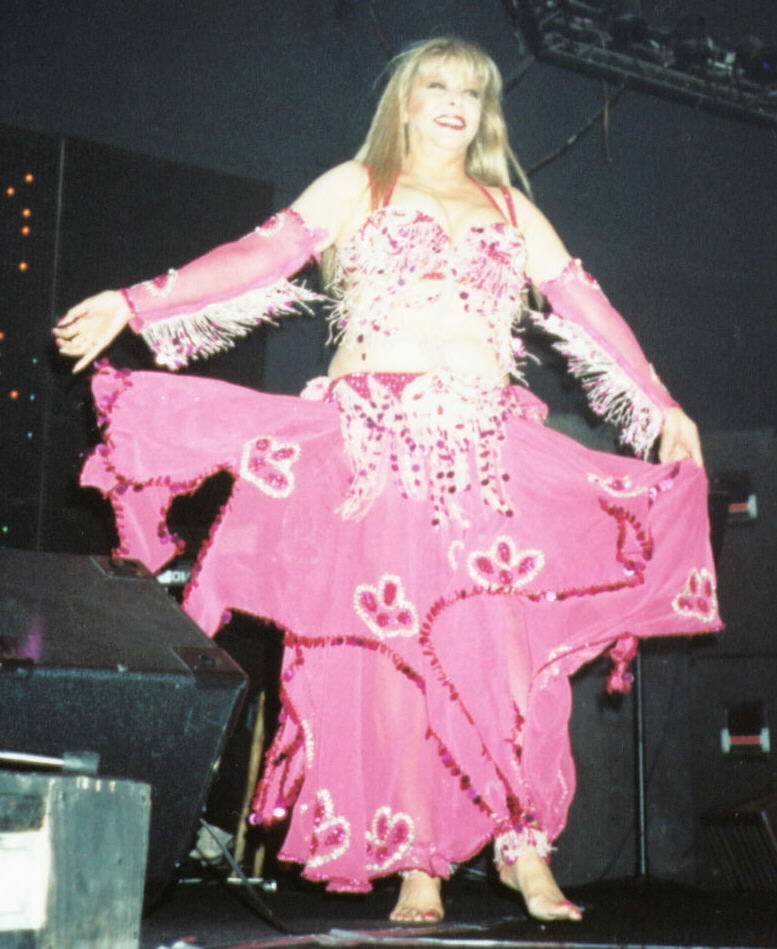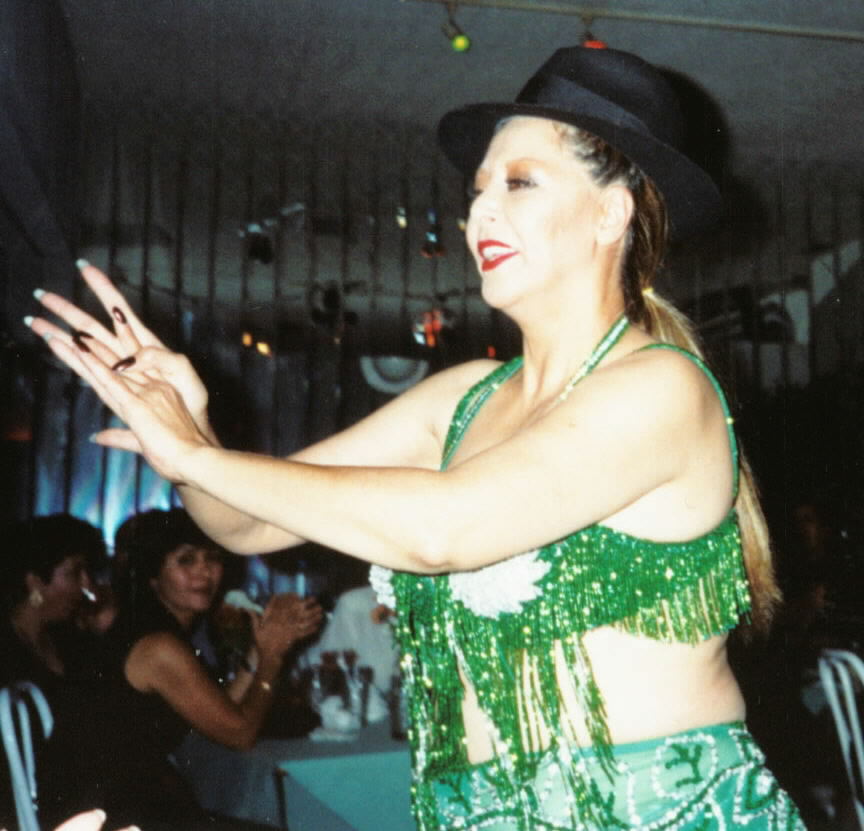JAMILEH
“The Goddess of Persian Dance”
Robyn C. Friend. Ph.D.
First published in Habibi, volume 16, number 1 (Winter 1997)
I first heard of Jamileh many years ago when a musician friend showed me a video of her from Iranian television in the 1960s and 1970s. On this video she performed several dances: a “classical” Persian dance, wherein she mimed a lady at her toilette; a cabaret-style belly-dance; and a jâheli dance, where she danced with a man’s hat and imitated the jâheli style of men’s dancing. She was the first professional Persian dancer I had ever seen, and I was charmed. She combined supple and subtle movements with great strength and flexibility, and had the most gorgeous hair!
Seeing her perform live is an even greater treat. What a performance! To say she is a good dancer misses the point: she is a great entertainer! The amazing thing is that, other than the addition of a few pounds, her dancing hasn’t changed in three decades, and her hair is still gorgeous. Her mixture of performing repertoire — belly-dance (called raqs-e arabi, in the Persian language), and Persian dance is essentially the same today as in that 30-year-old video.
In a recent performance at Cabaret Tehran, for example (where she has performed frequently over the past 17 years), she began her set with raqs-e arabi to a well-known Egyptian composition, wearing a standard cabaret costume of pink and silver. Weaving her way through the audience, she played with them, dancing on chairs and tables, making them laugh. She returned to the stage and spoke to the audience in Persian, welcoming them, expressing the wish that they have a good time, and telling a few jokes, some of them about herself. After introducing the musicians, she began a quick series of traditional Iranian dances: a brief jâheli bit, followed by Qâssemâbâdi (dance of Northern Iranian Caspian coast), and finishing with bandari (Persian Gulf). She left the stage and quickly returned with her hair pulled back and wearing the jâheli hat. In the Persian language, this hat is called kolah makhmali, a 20th century man’s fedora-style hat. The rest of her costume was unchanged.
The jâheli style is perhaps the most unusual Persian dance style, especially from the point of view of a non-Iranian. First of all, she wears this fedora and dances in a very masculine manner, her arms held straight, without the characteristic wrist turns of women’s dance. Then, there is “the lip thing”, a shimmy of the lower lip that looks most peculiar to the uninitiated. What is this all about? I have heard several explanations of the lip “shimmy”, ranging from that it is how a woman looks as she is about to cry, and that it is also imitative of orgasm. Whatever its origins and meanings, it is always a big hit with the Iranians in the crowd (Americans are always completely perplexed by it!), and was one of the gestures I was taught early in my own training as being de rigeur for the Persian dancer. Jâheli dance is part of an Iranian sub-culture that has its origins in 9th and 10th century, a period when eastern Iran especially suffered under the incursions of Turkic and Mongol tribes seeking pasturage and pillage. Local, informal constabularies were formed to protect each town or village. The men of these groups, called jâhel (meaning “ignorant” in Persian), along with their women, developed a group culture with an interesting mixture of street smarts and spirituality. The kolah makhmali is kind of a symbol of the jâhel man (somewhat analogous to pinstripe suits and 1930’s gangsters in the U.S.). In Jamileh’s dance, she is a jâheli woman imitating a jâheli man’s “tough-guy” style of dance; it is also more suggestive and overtly erotic than more traditional “classical” Persian dance.
After the 1905 constitutional revolution in Iran, Iranian traditional performing arts — dance in particular — fell out of favor with many Iranians. This was due to the desire to imitate not only western-style democracy, but also to adopt western-style culture, as though the latter could help bring about the former. Persian dance was looked upon as a degenerate art form — the province of prostitutes — and decidedly inferior to western forms of dance, such as ballet. Whether you like her dancing or not, Jamileh is important as either a social reformer, rehabilitating Persian dance and making it acceptable for Iranian audiences, or as a reflection of an increasing acceptance of Iranian traditional arts. With her appearances on television in Iran thirty and more years ago, Jamileh brought Persian dance “out of the closet” and into the public eye, where it was again appreciated for its beauties and charm.

Today Jamileh performs in cabarets in Los Angeles and elsewhere. Although she usually appears with her own drummer, who plays both Arabic darabukka and Persian tonbak, for a melody instrument she usually must settle for a single musician on synthesized keyboard, provided by the establishment where she is performing. Such instrumentation is inadequate to convey the subtlety of emotion and movement that characterizes Persian classical style; because of the lack of real Persian music in the night-clubs where she performs, she therefore restricts her performance largely to raqs-e arabi, with only a bit of Persian dance thrown in. Nonetheless, as long as she has her drummer with her on tonbak, she is able to perform to the range of Persian rhythms, from the normal 6/8 shir-e madar (literally “mother’s milk”; the term is perhaps used because the rhythm of the words can convey the rhythm of the musical meter), to the rolling 6/8 of the Persian Gulf, and the motrebi rhythm (which stretches the second beat of a syncopated 6/8 until it is almost 7/8).
Where to see Jamileh in Los Angeles
Jamileh can been seen at Cabaret Tehran, on an irregular basis. Call first to find out what nights she will be performing. The cover charge varies from $25 to $30, depending on the night, and includes a set dinner with 2 or 3 choices (chicken kebab, shish kebab, and fish, for example; I chose the chicken and it was delicious). The ambiance is strictly nightclub; bring earplugs if your ears are sensitive to loud music, or be prepared to do as I did — visit the restroom and discreetly insert tiny wads of toilet paper in both ears. Cabaret Tehran, 12229 Ventura Boulevard, Studio City; 818/985-5800. Valet parking. Reservations are a good idea.
Jamileh also appears at Miami Cafe, 1773 Westwood Boulevard, in Westwood. The $20 cover charge includes the 4+-hour show of singers, comedians, and Jamileh, plus a set dinner of your choice of kebabs (chicken, kubideh, soltani, barg, etc.) and rice, with a small salad. This is a smallish restaurant with a fairly intimate atmosphere. No seat is far from the dance floor and the performers. Beware the large screen television playing MTV before the show starts. Call beforehand (310/479-2411) for show times, reservations, and to make sure she is going to be there. Parking on Westwood Boulevard; since you won’t be arriving until 10:00 pm or so, that’s less of a problem than it sounds. Her performance at Miami was at about 1:00 am; at Cabaret Tehran, about 11:00 pm. Either way, plan for a late evening!
Raqs-e Jamileh Video
If you can’t get to see Jamileh in person, there is a video available fromPars Video that features all of her dance styles. This video is mostly from Jamileh’s television appearances in the late 1960s and early 1970s, a time period clearly reflected by the bell-bottomed costuming and men’s haircuts. At this time, westernization in Iran was at its peak among the upper classes; many Iranians had by then been educated abroad, and while Iranian traditional arts were making their comeback, it was still very fashionable in those circles to imitate the dress and culture of Europe and the United States (in these days of “Iran-bashing” in the U.S. and “U.S.-bashing” in Iran, it is instructive to remember how much interest in and goodwill towards the U.S. existed in Iran just a few years ago).
The following is a brief overview of the contents of the video:
-
- Bandari: On the video, Jamileh does several bandari style dances. These dances are from the people of the Iranian portion of Persian Gulf coast, primarily around the city of Bandar Abbas (bandarmeans “port” in Persian, Abbas was one of the Iranian shahs). These dances are very similar to other khaliji dances, though with a distinctive Persian flavor. Jamileh adds her own flare, with more hip isolations and torso undulations than would be found in Bandar Abbas. Also worth noting is that none of the costumes she uses (note especially the bright red backless halter jumpsuit and the white fringed “flapper” dress!) is “correct” for the area; they are instead a reflection of the cultural context of Iran in the 1970s.
-
- Jâheli: This is Jamileh’s specialty, and she does it well. The costuming, however, is strictly early-1970’s chic (again, the red halter jumpsuit, blue dress with cutouts), except for the kolah makhmali.

- “Persian Classical”: This style has its roots in the flourishing of dance that occurred in the 19th century under the Qajar shahs (see my previous Habibi article). Jamileh’s costumes are strictly fantasy; tightly-fitted flaring jersey dresses with cutouts in strategic places and lots of glitz, with headpieces of coins and jewels on a headscarf bear no relation to any traditional Iranian dress. Her dancing, though, is authentically Persian, with all of the coquetry and grace the style requires. In both the dances that appear in this video, she uses finger cymbals lightly as an accent, rather than as a constant rhythmic accompaniment (dancing with various items held in the hand used for rhythm-keeping has a long tradition in Persian classical dancing.).
The Jamileh video can be obtained from Pars Video, 18740 Oxnard Street, Unit 303, Tarzana, California 91356, telephone number 818/881-4881, -9881, or -1666. They take cash or money orders only (no credit cards or personal checks), so be sure to call first before either going there or sending money. Tapes are available in a variety of formats, including PAL, SECAM, and NTSC. The name of the video is “Raqs-e Jamileh” (“Jamileh’s Dance”), Tape #183.
The author wishes to acknowledge some of the many people with whom she has consulted on these matters over the years, including Morteza Varzi, Abdullah Nazemi, Haleh Farjah, Morroco, Medea Mahdavi, and many others.
